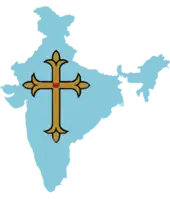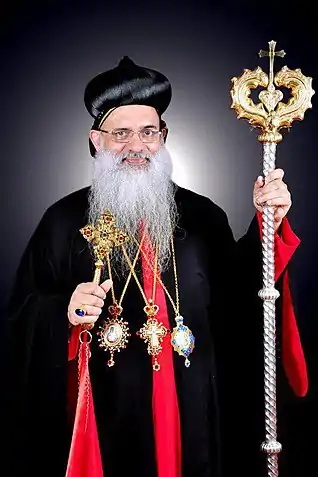Malankara Metropolitan
| Part of a series on |
| Christianity in India |
|---|
 |
Malankara Metropolitan is a legal title given to the head of the Malankara Nasrani Christians, by the Government of Travancore and Cochin in South India. This title was awarded by a proclamation from the King of Travancore and the King of Cochin. The Prime jurisdiction regarding the temporal, ecclesiastical and spiritual administration of the Malankara Church is vested in the Malankara Metropolitan.
After 1877, every denomination in the Malankara Church started claiming their prelate as Malankara Metropolitan. Among them the head of the Malankara Orthodox Syrian Church, (presently Baselios Mar Thoma Paulose II) was affirmed by the Supreme court of India as the Malankara Metropolitan in the verdict pertaining to the asset dispute with the Jacobite Syrian Christian Church.[1]
In 2002, after the enactment of the new bylaws for the Jacobite Syrian Christian Church, and in the light of verdicts from Supreme court of India in favour of the Malankara Orthodox Syrian Church, the Malankara Metropolitan officially assumed the title "Metropolitan trustee" of the Jacobite Syrian Christian Church. Metropolitan Trustee is Joseph Mor Gregorios.[2]
On the other hand, the title "Mar Thoma Metropolitan"[3][4] is used by the head of the Mar Thoma Syrian Church since 1894. The current Mar Thoma Metropolitan of Mar Thoma Church is Theodosius Mar Thoma
However, unlike the Malankara Orthodox Syrian Church, the Jacobite Syrian Christian Church doesnot believe that the Malankara Metropolitan is seated on the Apostolic see of Thomas Apostle nor as a successor to Thomas Apostle, but rather views the Malankara Metropolitan to be the Metropolitan of the Syriac Orthodox Arch-Diocese of Thomas Apostle, popularly known as Malankara Church.[5]
Lineage
Historically the primate or the leader of St Thomas Christians were known as Jathikku Karthavyan (leader of Community), Malankara Moopen (Elder of the Community), Archdeacon or Arkadyokon (High Priest). In the 16th century to resist the Latinization attempts of the Jesuits, it became necessary to elevate the Archdeacon to a position of 'Metropolitan Bishop' named as Mar Thoma. In 1653 the Archdeacon position was elevated to Bishopric by laying hands of twelve priests in the absence of a valid Bishop. This was an emergency step. Then onwards the Metropolitan Bishop assumed the honorific ecclesiastical title Marthoma. This title was used from 1653 to 1815. Later a regular 'Bishopric' was established in Malankara with the help of Gregorios Abdal Jaleel.
Title of Malankara Metropolitan
It was when Col. John Munro was the British Resident of Travancore, that Pulikkottil Joseph Ittoop Ramban was ordained as a bishop by Geevarghese Philexenos (Kidangan) (1811–29) of Malabar Independent Syrian Church (Thozhyoor Church) on 22 March 1815. He was given the episcopal title Dionysius II, as he was the second bishop in the Malankara Church to get this title. After the death of Thoma VIII, he was made the head of the Malankara Church by a Royal proclamation issued by the King of Travancore and later by the King of Cochin. The proclamation insisted every Malankara Syrian Christian of Travancore-Cochin obey the Malankara Metropolitan. From then onwards the head of the Malankara Church legally came to be known as Malankara Metropolitan. The position of the Malankara Metropolitan in the 19th century is an upgrowth from the position of the previous Thomas and Archdeacons. The power and authority of the Malankara Metropolitan got more recognition than the power and authority of the previous Archdeacons' and Marthomas' because the British Residents of Travancore were favorably disposed towards the Malankara Church.[5]
From 1816, Dionysius II, Dionysius III, Dionysius IV and Mathews Athanasius were successive Malankara Metropolitans. However inspired and encouraged by the Anglican missionaries who had taught at the old seminary in Kottayam, Mathews Athanasius wanted to reform the traditional Syrian church. A parallel group under Dionysius V was working against his reformational schemes. During the latter half of the 19th century there occurred two factions in the community; the minority faction that favored reformation and the majority faction who were against it. Dionysius V of the (Syrian traditionalists; Jacobite Syrian Christian Church) invited and brought Ignatius Peter IV of Antioch to Malankara in 1875. The Patriarch divided the Malankara church into seven dioceses; Dionysius V was declared as the Malankara Metropolitan and was given charge of Quilon Diocese in the synod of Mulanthuruthy (27 to 30 June 1876). Neither the incumbent Metropolitan Mathews Athanasius nor the Churches favoring him participated in the synod.[6]
A series of court cases followed thereafter. The Travancore Royal court, by order on 14 July 1889 declared that Dionysius V due to his allegiance to the See of Antioch and acceptance by the majority of Malankara Syrians, is the rightful Malankara Metropolitan and Thomas Athanasius has no rights or claims to that office.[7] Thus the reformed faction separated and organized themselves as the independent Mar Thoma Syrian Church. The majority faction that kept Oriental Orthodox faith came under the leadership of the new Malankara Metropolitan Dionysius V, subject to the Patriarch of Antioch is known as Jacobite Syrian Christian Church.[6][5][1]
In 1911, the church was divided into two factions due to internal disputes. Since then the faction that supported the patriarch of antioch was known as Bava Kakshi (Patriarch faction) or the jacobite church and Methran Kakshi (bishop faction) or Malankara orthodox who supported Vattasseril Thirumeni(bishop)[8] later Methran Faction(Malankara Orthodox Syrian Church) ordained Catholicos in 1912 by excommunicated Patriarch Ignatius Abded Mshiho II creating fear in the Malankara Church that he would attempt to take control of the church, reversing the decisions of the Council of Mulanthuruthy in 1876.[9] There were several years of litigation between the two factions, the Metran faction, and the Bava faction. The Supreme court of India declared that the Patriarch has no power in Malankara Church and his spiritual power had also come to vanishing point since the establishment of Catholicate.[10][11][12] This caused the Malankara Church to split into,
- Jacobite Syrian Christian Church: under the Patriarch of Antioch who still believes in the spiritual powers of the Patriarch and remains under the Maphrian / Catholicos of the Syriac Orthodox Church, later established Catholicos of India.
- Malankara Orthodox Syrian Church: Headed by Malankara Metropolitan and Catholicos of the East seated on the Apostolic See of Saint Thomas.
Electing Catholicos Geevarghese II as Malankara Metropolitan
After the death of Malankara Metropolitan Geevarghese Dionysius VI of Vattasseril(1934); the Malankara Association held at M.D Seminary Kottayam elected Catholicos Baselios Geevarghese II as the Malankara Metropolitan and passed a Constitution for Malankara Orthodox Syrian Church popularly known as 1934 CONSTITUTION or Malankara Orthodox Syrian Church Constitution.
Since 1934, the Catholicos of the East is holding the Office of Malankara Metropolitan.
Malankara Association 2002 at Parumala
According to Supreme Court order, the Malankara Syrian Christian Association (Parliament of the Malankara church) was conducted under the observation of Supreme Court of India in order to set right the position of Malankara Metropolitan H.H Catholicos Baselios Mar Thoma Mathews II.
The Association Meeting held on 20 March 2002 at Parumala Seminary elected Baselios Mar Thoma Mathews II as the Malankara Metropolitan. The secret ballot voting was conducted at the Seminary and result was declared by the Supreme Court Observer Justice V.S. Mulimud. Total polling was 3483 votes. Out of this 3464 votes were cast in favour of Baselios Mathews II, 10 voted against and 9 were invalid. The total delegates registered for the Association was 3528., "The supreme authority of the Malankara Syrian Christian Association has been unambiguously approved by the Supreme Court.The factions no longer exist and there is only one official Malankara Church." The election was held as per the Supreme Court's 1995 judgement on the dispute in the Malankara church.
However, this meeting was boycotted by the Jacobite Syrian Christian Church, who were not happy with its overall conduct.[13][14]
References
- "CNEWA Profiles". CNEWA.
- Staff (2019). "Mar Gregorios is Jacobite Church metropolitan trustee". The Hindu. Retrieved 2 November 2020.
- "Mar Theodosius to be installed as 22nd Mar Thoma Metropolitan on November 14 – New Indian Express". New Indian Express. 29 October 2020. Retrieved 14 November 2020.
- "Theodosius to be new Mar Thoma Metropolitan – The Hindu". The Hindu. 28 October 2020. Retrieved 14 November 2020.
- Neill, Stephen (2002). A History of Christianity in India: 1707-1858. Cambridge University Press. pp. 236–254. ISBN 978-0-521-89332-9.
- MacKenzie, Gordon Thomson (1901). Christianity in Travancore. Trivandrum : Printed at Travancore Govt. Press. pp. 39–43.
- Travancore Royal Court Judgement 1889. 1889.
- Korah thomas, Antony (1993). The Christians of Kerala. University of Michigan. p. 97.
- "Mulanthuruthy Synod Decisions". www.syriacchristianity.info. Retrieved 11 November 2020.
- Sahai, R. "Supreme Court of India Most. Rev.P.M.A. Metropolitan & ... vs Moran Mar Marthoma Mathews & ... on 20 June, 1995".
- Yamunan, Sruthisagar. "In Kerala, a legal battle between two Christian factions has spilled into the streets". Scroll.in.
- "Malankara church row: All you need to know about century-old dispute between Jacobite, Orthodox factions in Kerala". Firstpost.
- "Supreme Court mandated election fails to resolve dispute of Orthodox Syrian Church". Kerala. 8 April 2002. Retrieved 7 November 2020.
- 2002 Parumala Association Facts
Sources
- Frykenberg, Robert Eric (2008). Christianity in India: From Beginnings to the Present. Oxford: Oxford University Press. ISBN 9780198263777.

